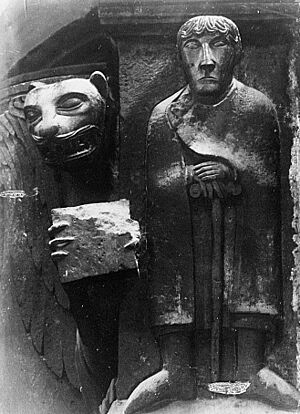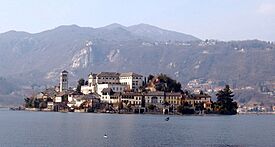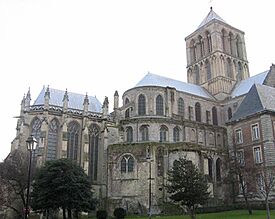William of Volpiano facts for kids
Quick facts for kids Saint William of Volpiano |
|
|---|---|

William of Volpiano;
Basilica San Giulio (12th century) |
|
| Born | June/July 962 San Giulio Island, Piedmont, Kingdom of Italy |
| Died | 1 January 1031 |
| Honored in | Catholic Church Eastern Orthodox Church |
| Feast | 1 January |
Saint William of Volpiano (also known as William of Dijon or William of Fécamp) was born in June or July 962 and passed away on January 1, 1031. He was a very important person from Northern Italy. He helped change and improve monasteries, which are places where monks live and pray. He was also a composer and started many abbeys (large monasteries) in places like Burgundy, Italy, and Normandy.
Contents
William's Early Life
We don't know a lot about William's life. Most of what we know comes from a book written by a monk named Raoul Glaber. Raoul was a young monk who traveled with William. He saw William as a teacher who encouraged him to write stories about history.
William was born on an island called San Giulio, which is in Lake Orta in Piedmont, Italy. His family had a strong castle there. His father was Count Robert of Volpiano. William was born during an attack on the castle by the Emperor Otto. The Emperor won the battle and became a special helper and supporter for William, who was Count Robert's son.
William was the fourth son in his family. In 969, when he was seven years old, he started his education at a Benedictine monastery in Locadio, Italy. He later became a monk there. In 987, he joined the famous Abbey of Cluny and studied under Saint Majolus. Saint Majolus was very keen on making monasteries better. He had already reorganized another monastery called Saint-Sernin Abbaye near the Rhône River.
William's Work as an Abbot
William became a priest in 990. He then became the abbot (the leader) of Saint Benignus' Abbey in Dijon, France. This abbey was named after Saint Benignus of Dijon. Under William's leadership, Saint Benignus' Abbey became a very important place. It was known for its spiritual teachings, great education, and rich culture.
This abbey also became the main center for about forty other monasteries. These monasteries were located in Burgundy, Lorraine, Normandy, and northern Italy. William helped spread the ideas of the Cluniac reform, which aimed to improve the way monks lived and practiced their faith.
In 1001, William was asked to rebuild the Abbey of Fécamp in France. This abbey had been destroyed. Richard II, who was the Duke of Normandy, wanted it rebuilt because his family had a palace there and chose to be buried there. William was in charge of rebuilding Fécamp and also starting several new abbeys in Normandy, such as Bernay Abbey and Mont Saint-Michel. In 1015, he also became the abbot of Jumièges Abbey.
Building Mont Saint-Michel
William was chosen to be the main builder for Mont Saint-Michel in the 11th century. He designed the Romanesque church for the abbey. He was very bold in his design, placing the main part of the church (the transept crossing) right at the very top of the mount. To support this heavy structure, many underground crypts (hidden rooms) and chapels had to be built. These underground structures formed the strong base for the amazing building you can see today. William also helped rebuild the Abbey of Saint-Germain-des-Prés.
William passed away peacefully from natural causes at Fécamp.
See also
- William of Volpiano's fully notated tonary for the use at the Abbey Saint-Bénigne of Dijon
Images for kids






